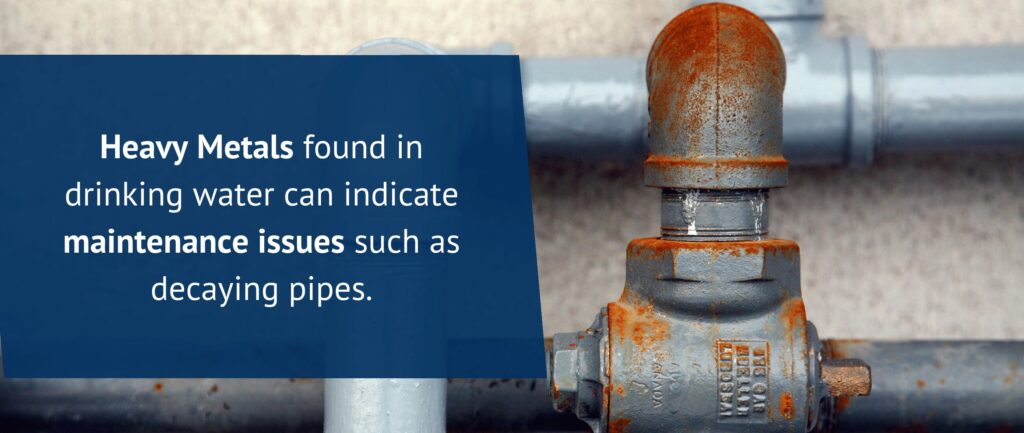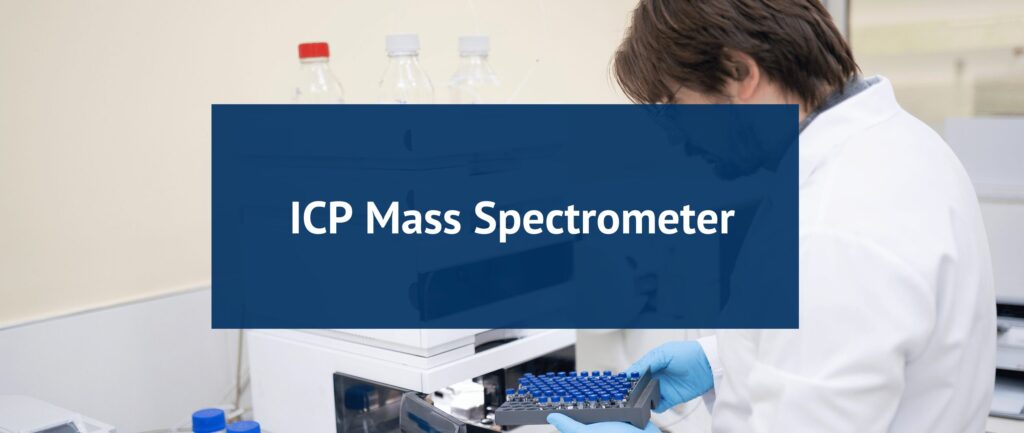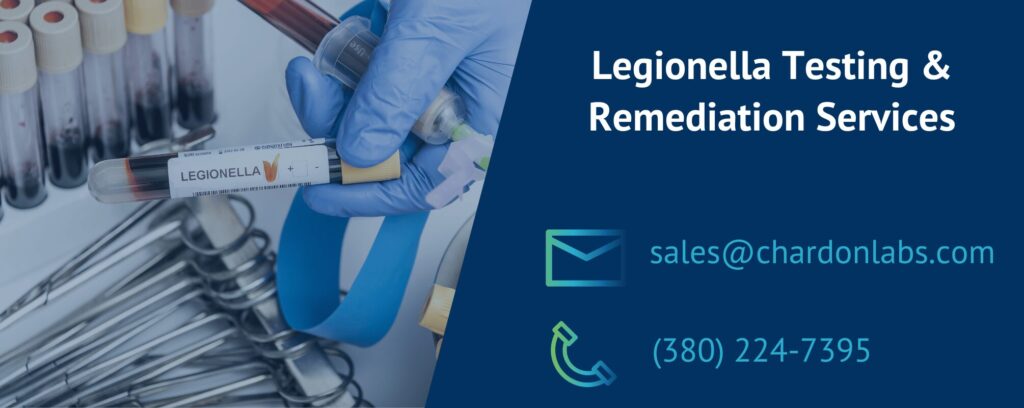
The potability of your building’s tap water is a liability. If a person develops health complications because of the drinking water quality, they could hold the building owner accountable. There are laboratory tests for water contaminants to identify these problems. Schools, manufacturers, offices, hospitals, hotels, apartments, and retirement homes should all consider this a priority for the safety of its inhabitants. As of February 2024, GSA recently released its Water Testing Modification Effort, which requires regular water quality testing at its government owned buildings.
Contaminants such as heavy metals, nitrates, bacteria, viruses, and protozoan should be tested. Harmful contaminants can result in health problems. Children and at-risk demographics are particularly susceptible.

Heavy metals are a health risk that can cause neurological damage, kidney disease, liver problems, and reproductive issues amongst other health concerns. Children are particularly at risk of developing issues.
Lead poisoning causes neurological disorders, especially in children. In the United States public lead pipes were banned in 1986. Due to this, older buildings are at risk of lead contamination. Even small amounts of lead are unsafe for the potability of tap water.
To identify lead piping, suspect installs before 1986. Check the copper pipe with lead solders, older faucets, galvanized pipes (from zinc coating), goosenecks, and the service line.
Copper can be processed in most healthy bodies, however, and issues typically arise from damaged or corroded pipes. Causes liver damage, kidney disease, and red blood cell problems. It is worth noting that infants and certain at-risk populations cannot easily remove copper.
Newer buildings typically utilize PVC or PEX piping over copper. A benefit of copper is that it has antimicrobial properties compared to plastic piping.
Manganese has a similar health effect to lead, leading to neurological disorders. Infants and those older than 50 are more sensitive to manganese leading to health issues. Unlike lead, it is fine for your body to have some levels of manganese, the dangers are in excess.
Manganese is present in nature from soil and rocks. Groundwater and surface water sources contain levels of manganese that could end up in drinking water.
Unlike other metals, iron does not pose a health risk. It is a water quality issue that will make the tap water taste bad, stain, and turn a yellow or orange color.
Iron can come from rust in corroded pipes. It can also come from soil and rock where water erodes the surface or groundwater sources.
A dangerous toxin, mercury, can cause vision blindness, memory loss, kidney failure, and immune system changes. Young children are at a higher risk of developing complications from mercury.
Mercury can enter drinking water sources in various ways. Precipitation from airborne mercury, hazardous waste, mercury-based pesticides, fossil fuel burning, etc.

Laboratory testing for heavy metals has two common methods of detection. One of these methods is inductively coupled mass spectrometry, also called ICP or MS. This laboratory test involves a tube sucking samples into the spray chamber. The spray chamber vaporizes the sample. A plasma torch then makes an electromagnetic field. The sample absorbs energy from the torch and creates a light wavelength. This wavelength is analyzed to detect the presence and quantity of heavy metals. The other common method is anodic stripping voltammetry, which is a mobile unit that can be moved to test anywhere. Metals are reduced on mercury electrodes from a current. A doped electrode is then utilized as a conductor. The measurement is taken from the electrode’s plated metal which shows the concentration of heavy metals.
Agriculture fertilizer and manure are common ways in which nitrates enter potable water. Nitrates in tap water cause problems with the way blood transfers oxygen. Thyroid disease and colon cancer are other effects of high levels of nitrate in drinking water. Nitrates can cause birth defects and Methemoglobinemia, a disease where infants have blue skin due to blood complications. High heart rate and abnormally low blood pressure may occur.
The Cadmium Reduction Method is a common way to test for nitrates in potable water. Cadmium reduction involves contacting cadmium particles to nitrate, this reaction causes the nitrate to become nitrite. A separate reagent then reacts with the nitrite and makes the sample turn red. The red shade color of the nitrite will be proportional to the amount of nitrate present. The shade of red then be compared on a color wheel to determine the concentration of nitrate in the sample.

The Legionella bacteria in water causes Legionnaires disease, a dangerous form of pneumonia. Those aged 50+, smokers, immunocompromised, and people with lung diseases are particularly at risk of the infection developing. It also can cause Pontiac fever in its most mild form.
Chardon Labs offers fast, same-week testing. We pull the samples for you and offer remediation services as well. To learn more about our Legionella service offering, click here!
Certain strains of Escherichia Coli are caused by fecal matter from humans or animals. E. Coli can cause Pneumonia, kidney disease, and gull batter problems. Mild cases of it may only cause diarrhea. E. Coli typically lives in the lower intestine of your gut.
Salmonella lives in the gastrointestinal tract. Like E. Coli, fecal matter from animals or humans can cause this to be present in potable water. Diarrhea, nausea, and vomiting are common symptoms of salmonella in drinking water.
One of the most dangerous forms of bacteria is cholera, also known as blue death. It is commonly caused by fecal matter contamination. Diarrhea, vomiting, dehydration, and electrolyte imbalance are symptoms caused by cholera in potable water. This bacterium is rarer but much more dangerous than most forms of bacteria in drinking water.
A common method that labs utilize to test for bacteria in potable water is sampling with agar plates. Agar plate sampling involves using clear plastic or glass dishes (Petri dishes). The equipment and petri dish environment needs to be sterilized, flame heat for the metal instruments and alcohol for the petri dishes are a common method to do this. The agar is then added. Agar is a gelatin-like ingredient formed from red seaweed, which is what the bacteria will grow on and use for nutrients. The agar plate will need a substance to inoculate it, such as the mycelium in mushrooms. The inoculate will need to be added to the syringe with the eater sample. This sample will then need to be incubated (incubating involves heating at a certain temperature for a period) around 80°F or 26.6°C. The bacteria that is grown will be able to be tested.

Adenovirus is a rugged, difficult-to-kill virus that can live in many water sources that potable water comes from. It survives longer in water than most viruses. It can be responsible for the common cold, flu, pink eye, pneumonia, and sore throat.
There are several forms of hepatitis found in potable water. Some common symptoms include abdominal pain, fatigue, vomiting, nausea, and jaundice.
The protozoan (not bacteria or virus) Giardia can cause diarrhea, weight loss, and stomach aches. It is the most common waterborne disease in the United States. Giardia is not usually dangerous when compared to some of the more severe types of bacteria found in potable water.
The second most common form of diarrhea in young children. This common protozoan, like many other organic contaminants, comes from fecal matter in tap water. It leads to respiratory and gastrointestinal illnesses and watery stool.
A common method of testing for potable water viruses in laboratories is PCR tests. People are familiar with PCR tests from Covid-19 viral testing. Polymerase Chain Reaction testing shows qualitative data about the virus and qPCR SYBR Green testing shows real-time quantitative data about the virus. It detects both the presence and quantity of suspected viruses. qPCR lab testing involves DNA polymerase attaching to a template. This template DNA binds and fluoresces (glows like ultraviolet). The intensity of this fluorescence is then measured to see the quantity of the virus present.